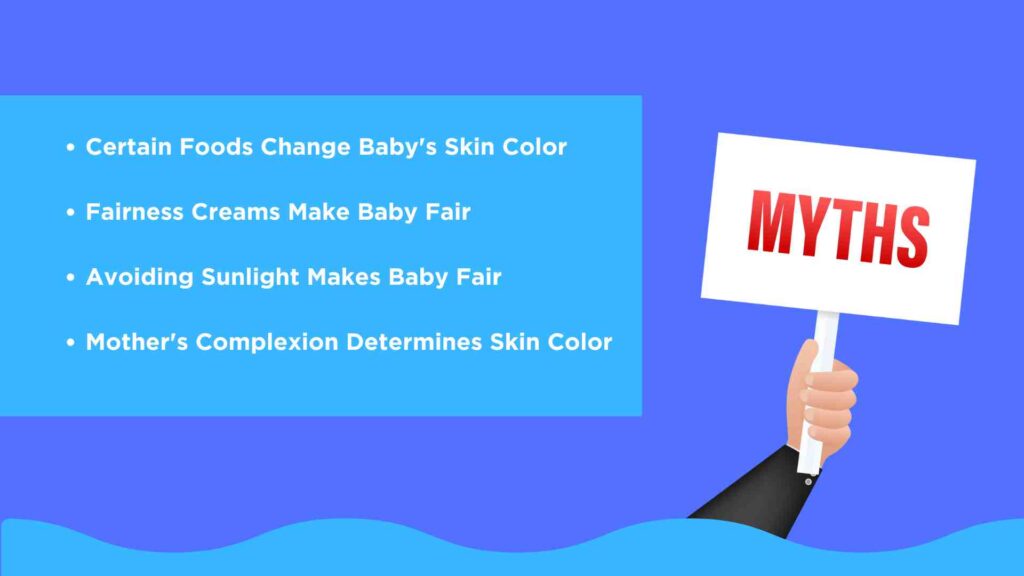Summary: The skin color of a baby during pregnancy depends on multiple genes. It’s a polygenic trait. When a baby gets skin color genes from both mom and dad, it’s like getting different color ingredients. These different genes mix together to decide the baby’s skin color.
Are you also curious about what decides the skin color of a baby during pregnancy? It’s a question many soon-to-be parents wonder about. Let’s dive into this fascinating topic!
When a baby is growing in mom’s tummy, lots of things happen. The little one is developing bit by bit, and that includes its skin color. It’s like a magical recipe, with ingredients from both mom and dad.
It’s not as simple as mixing paint but a complex and fascinating process. Nature has its own special way of blending things. Sometimes, the baby looks just like mom, sometimes like dad, and sometimes a perfect mix of both! It’s a journey of discovery that will keep you intrigued.
So, what’s really going on in there? How does a baby end up with a unique skin tone? Or how to improve baby skin color during pregnancy? But first things first, let’s clear the air:
Can We Improve Baby Skin Color During Pregnancy? Or is it Just a Myth?
Well, there is no scientific proof that anything you eat or do can change your baby’s skin color — it’s mostly decided by genetics. What you can do is focus on eating healthy, taking your supplements, and ensuring good nutrition for overall baby development and healthy skin.
I still remember when I was pregnant, my mother used to tell me to drink saffron milk regularly, saying it would make the baby’s skin fairer. She even told me stories of how women in our family followed this ritual during pregnancy.
At that time, I was curious and wondered if these things could actually work. But later, when I spoke with my doctor, I realized that skin color is something you cannot control — it’s in the genes. Still, I did enjoy a warm glass of saffron milk now and then, more for comfort and the love behind my mother’s advice than for changing my baby’s skin tone.
When Does Baby Skin Color Develop During Pregnancy?
Did you know your baby’s skin starts growing really early? It’s true! The process of baby development in the womb is amazing, and the skin is one of the first organs to begin forming. When you’re just 5 to 8 weeks pregnant, your little one is already working on their skin.
At this point, the baby is tiny – smaller than a raspberry! But even then, their skin is starting to form. It’s like they’re putting on their first outfit, but it’s made of cells instead of cloth.
The skin starts off simple, with just two layers. Think of it like a sandwich. The bottom layer is called basal cells. These are the building blocks that will grow into more skin later. The top layer is called the periderm cells. They’re like a protective blanket for the growing skin underneath. At 18 months, your baby’s skin is transparent.
What Factors Are Crucial to Decide the Skin Color of a Baby?
These are some crucial factors that are generally considered to decide the skin tone of your baby:
1. Genetics
One of the biggest and most well-known factors that decide the skin of a baby is genetics. It is like a complex recipe book for your baby’s appearance. Each parent contributes half of the genetic instructions. These genes interact in intricate ways, determining not just skin color but also hair, eye color, and other traits. It’s not as simple as blending two colors – sometimes recessive genes can surprise us, giving a baby a skin tone that might not look like either parent’s.
2. Melanin Production
Melanin is the key player in skin color. There are two types: eumelanin (brown and black pigments) and pheomelanin (red and yellow pigments). The amount and type of melanin determine skin color. Babies can produce melanin at birth, but full melanin production starts after birth. This is why many babies’ skin darkens over time.
3. Sun Exposure
Our skin produces melanin as a natural sunscreen. When exposed to UV rays, melanocytes (special skin cells) produce more melanin to protect the skin. This is why people often get darker in the summer. Even indirect sunlight can trigger this process for babies, gradually darkening their skin over time.
4. Nutrition
Foods rich in vitamins A, C, and E and omega-3 fatty acids contribute to baby skin color development during pregnancy. After birth, breastfed babies get skin-supporting nutrients through milk. Formula-fed babies get these from fortified formula. As babies start eating solid foods, their diet affects skin health and appearance.
5. Hormones
Sometimes, during pregnancy, the mother’s hormonal setting may interfere with the melanin production in the baby. As soon as these hormones begin to leave your baby’s system after delivery, you may notice your skin color change. Furthermore, the baby’s melanin production now becomes regulated by his or her own hormones, which further causes changes in skin color within the first few months of life.
6. Time of Year
Babies born in summer may have a slight dark complexion at birth because of increased melanin production, probably triggered by sunlight falling on the mother during the last months of pregnancy. Winter babies may be much fairer at the beginning, but this difference usually settles over time.
7. Medical Conditions
Skin color also changes because of certain health conditions. One of the common issues is jaundice. It can be caused by a high level of bilirubin in the blood, giving the skin a yellowish complexion. A rare genetic disorder like albinism may also cause the skin and hair to be extremely light in color. If skin color changes unusually, it is always appropriate to have it checked by your doctor.
Is There Any Way to Get a Fair Skin Child During Pregnancy?
Science has no evidence of any remedy available during pregnancy that can lighten a baby’s skin color. It’s usually gene-based. Vitamins A, C, and E, Omega-3 fatty acids, folic acid tablets, and antioxidants are some nutrients that contribute to bringing about a difference. They help in good skin development and healthy skin tone for the growing baby inside the womb.
How Does Your Baby’s Skin Tone Change From Birth?
A baby’s skin tone can change significantly during the first few months and years of life. Here’s an overview of how this process typically occurs:
- At birth: Many babies have skin that appears lighter or darker than their eventual tone. This is normal and can be influenced by various factors such as blood circulation and remnants of vernix.
- First few weeks: The baby’s initial skin color may change as its circulation stabilizes and it adjusts to the outside world.
- 3-6 months: Melanin production increases, which can lead to the skin darkening. This is when many parents start to see their baby’s true skin tone emerging.
- 6-12 months: The skin tone continues to develop and may become more consistent.
- Toddler years: By age 2-3, a child’s skin tone is usually close to what it will be throughout childhood, though minor changes can still occur.
- Puberty and beyond: Hormonal changes during puberty can affect skin tone. Sun exposure over time can also influence skin color.
It’s important to remember that skin tone is determined by genetics, and various factors, including sun exposure, can influence this. Every baby develops at their own pace, and variations in skin tone are entirely normal.
When Can You Know Your Baby’s True Skin Color?
Babies are born with a wide range of skin tones. A newborn’s skin color does not necessarily indicate its final complexion. Over time, a baby’s skin tone changes, typically settling into its long-term shade by around 20 months of age.
It’s important to note that genetics play a complex role in determining a child’s appearance. As a result, a baby might resemble one parent more than the other or may not closely resemble either parent. This variation is completely normal and is part of the unique genetic makeup each child inherits.
Top Myths and Facts on the Skin Color of a Baby During Pregnancy

Myths 1: Eating certain foods can change the baby’s skin color
It’s a common myth that certain foods or drinks, like saffron milk or almonds, can alter the baby’s skin color during pregnancy. However, it’s important to understand that the baby’s skin color is primarily determined by genetics and melanin production, not by the mother’s diet.
Myth 2: Using fairness creams or lotions during pregnancy will make the baby fair
Some believe applying fairness creams or lotions during pregnancy can lighten the baby’s skin. However, the truth is these products do not affect the baby’s genetic makeup or skin color.
Myth 3: The mother’s complexion determines the baby’s skin color
It’s a common misconception that the baby will automatically inherit fair skin if the mother has a fair complexion. Skin color inheritance is determined by a complex combination of genes from both parents, not solely by the mother’s complexion.
Myth 4: Avoiding sunlight during pregnancy will make the baby fair
There’s a belief that exposing the pregnant woman to less sunlight or avoiding sun exposure can lead to a fair-skinned baby. However, sunlight exposure during pregnancy is essential for vitamin D production and overall health and does not impact the baby’s skin color in this way.
Final Thoughts
I hope now the skin color of a baby during pregnancy depends majorly on genes. So, there is no way to make your skin child’s skin fair. However, some people believe that with a proper diet and less sun exposure, there is a possibility to lighten a baby’s skin tone. Have some more doubts? Mention them in the comment section below.




